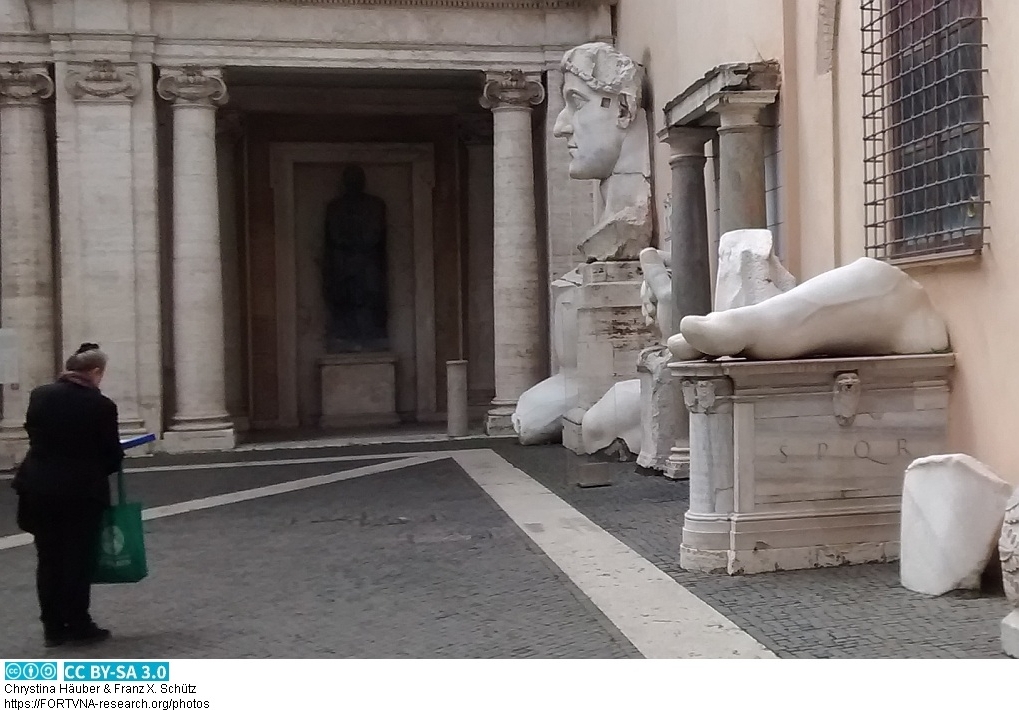
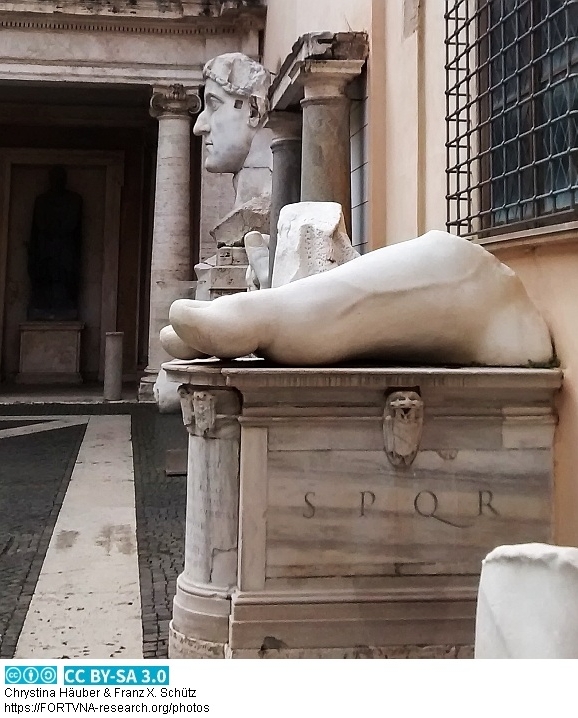
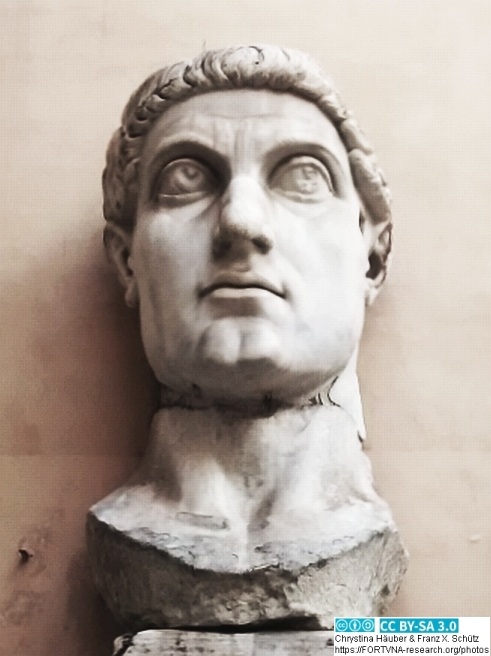


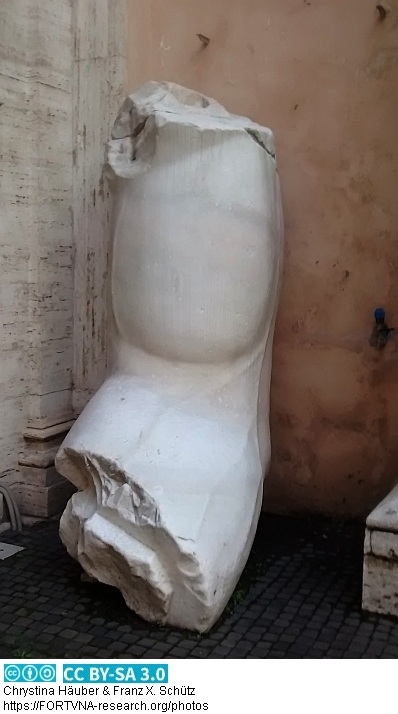
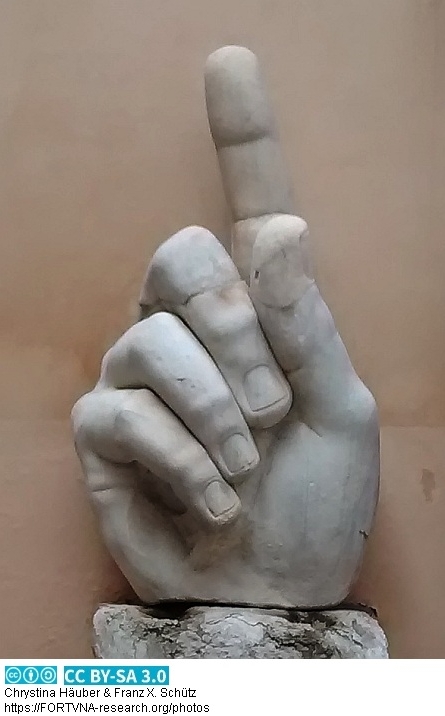
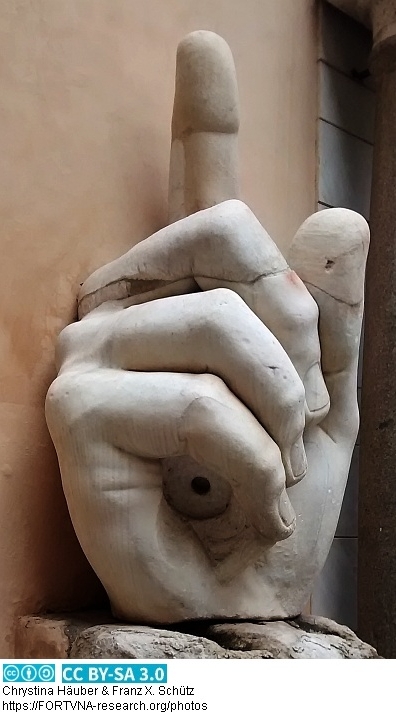
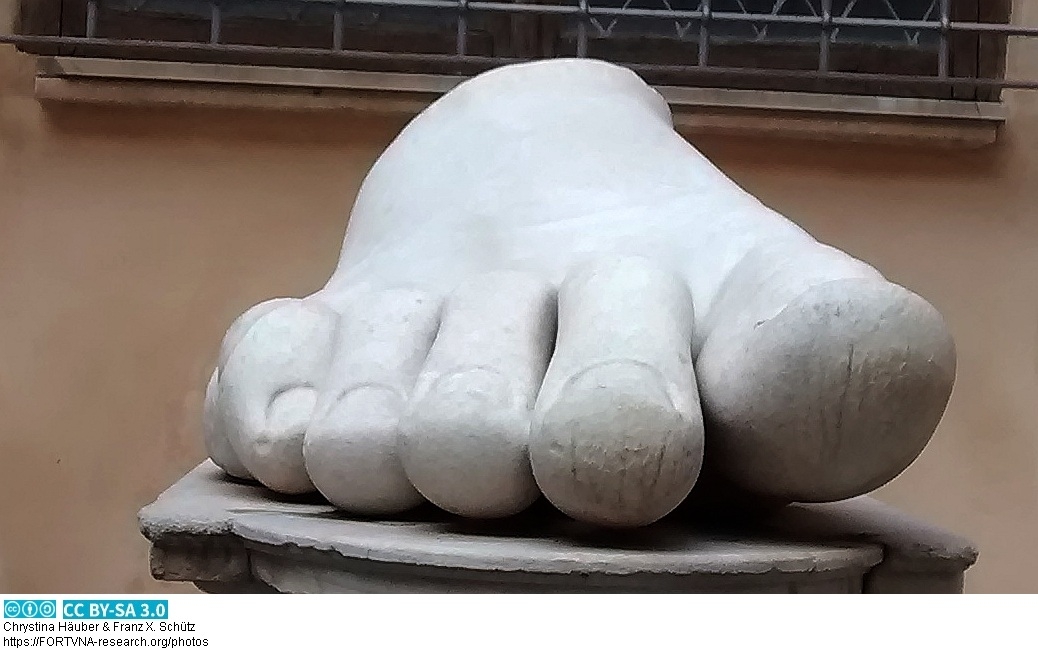
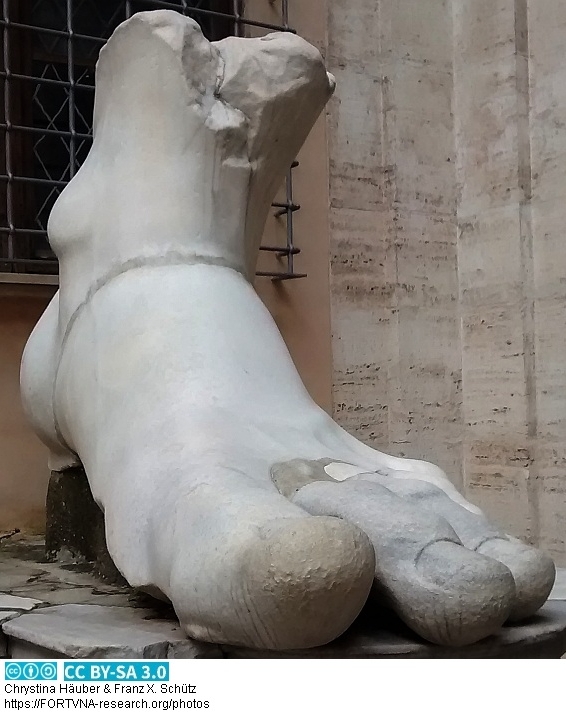
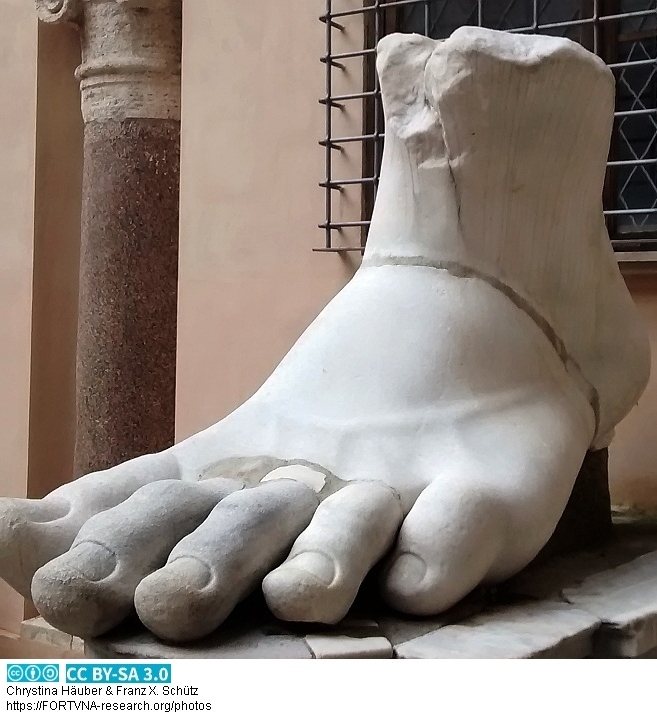
Chrystina Häuber behandelt die Feststellung, dass der Kopf einer kolossalen Statue des Hadrian in einen Konstantin (der Große) umgearbeitet worden ist in ihrem Buch über Domitian insbesonders in folgendem Kapitel:
"A Study on the colossal portrait of Hadrian (now Constantine the Great) in the courtyard of the Palazzo dei Conservatori at Rome (cf. here Fig. 11). With The Contribution by Hans Rupprecht Goette on the reworking of the portrait of Hadrian (now Constantine the Great)...
...
This colossal portrait of Constantine the Great turned out to have originally been a portrait of Hadrian. This hypothesis has (in my opinion convincingly) been suggested by Cécile Evers (1991). It was first followed by Amanda Claridge (1998, 382; ead. 2010, 465, who does not provide a reference though - but who had discussed this fact with me in Rome, as soon as C. EVERS's article had appeared in 1991), and rejected by other scholars. I myself hope to add some new observations, which further support Evers's hypothesis. The same is definitely true in the case of Hans Rupprecht Goette's findings. For his new observations concerning the `metamorphosis´ from Hadrian's to Constantine's portrait here Fig. 11; cf. below, at The Contribution by Hans Rupprecht Goette on the reworking of the portrait of Hadrian (now Constantine the Great).
...
Evers (1991) had further suggested that five inscriptions, found in the Forum Romanum, could (in theory) have belonged to this colossal portrait of Hadrian (now Constantine; cf. here Fig. 11), among them the fragmentary inscription CIL VI 974 = 40524 (cf. here Fig. 29.1). This inscription belonged to an honorary portrait-statue of Hadrian, dedicated by the Senate and the Roman People to commemorate Hadrian's victorious suppression of the Bar Kokhba Revolt, as has (in my opinion convincingly) been suggested by Michaela Fuchs (2014, 130 with ns. 45-47, Abb. 8 [= here Fig. 29.1]).
According to Geza Alföldy (at CIL VI 40524; cf. here Fig. 29.1) and Michaela Fuchs (op.cit.), this inscription was not found in the Roman Forum, as assumed by Evers (1991), but instead close to, or within, the Temple of Divus Vespasianus; the authors therefore assume that this statue of Hadrian was on display within the Temple of Divus Vespasianus.
At first, I had followed Evers's (1991) hypothesis, according to which the colossal portrait of Hadrian (now Constantine the Great; here Fig. 11) could have belonged to the inscription CIL VI 974 = 40524 (here Fig. 29.1), and had, at the same time, considered Geza Alföldy's (at CIL VI 40524) and Michaela Fuchs's (2014, 130) conclusions that the statue, to which this inscription (here Fig. 29.1) belonged, was on display within the Temple of Divus Vespasianus. - But note that neither Geza Alföldy or Michaela Fuchs suggest, which one of Hadrian's statue-types could have belonged to this honorary inscription (Fig. 29.1)
...Contrary to my first, above-mentioned hypothesis concerning the inscription (CIL VI 974 = 40524; here Fig. 29.1), I now suggest that it belonged to the original portrait-statue of Hadrian, of which almost 30 copies are known, among them the cuirassed statue of Hadrian from Hierypydna in Crete at Istanbul (cf. here Fig. 29).
Cf. below, at A Study on Hadrian's portrait-statue from Hierapydna (cf. here Fig. 29); and infra, in volume 3-2, at Appendix IV.c.2.).
Consequently, I am unfortunatly unable to make a suggestion, for which context this colossal portrait of Hadrian (now Constantine; cf. here Fig. 11) had originally been created.
...
Considering at the same time the possibility that this statue of Hadrian/ Constantine (here Fig. 11) actually was the portrait of Constantine described by Eusebius (Hist. Eccl. 9,9,10-11
) , Constantine's above-mentioned addition of his inscription to this portrait becomes all the more understandable. Because, as Constantine stated in this inscription, the choice of the `salvation-bringing sign [that his statue was holding in its right hand - which some earlier scholars have identified with a cross]´, which, as Eusebius reports, Constantine had ordered the artists to represent in the statue, had transformed this `Jupiterlike´ portrait of Constantine (cf. here Fig. 11) into something completely new.But as we shall see below, I myself follow now those scholars, who do not believe that the statue of Constantine (here Figs. 11; 11.1) was the one which Eusebius has described.
When the manuscript of this volume was about to be sent to the press, Franz Xaver Schütz alerted me to the book by Klaus M. Girardet (Der Kaiser und sein Gott. Das Christentum im Denken und in der Religionspolitik Konstantins des Großen, 2010, 92), who has likewise come to the conclusion that the colossal statue of Hadrian/ now Constantine the Great (here Figs. 11; 11.1) is not the statue described by Eusebius (Hist. Eccl. 9,9,10-11). To Girardet's observations concerning this colossal portrait of Constantine I will come back below.
In the following, I will discuss Cécile Evers's (1991) hypothesis, according to which this portrait of Constantine (cf. here Figs. 11; 11.1) was originally a portrait of Hadrian (together with this portrait will also be discussed the inscription CIL VI 974 = 40524; cf. here Fig. 29.1, which C. EVERS 1991 has tentatively attributed to this portrait). Evers's hypothesis was first followed by Amanda Claridge (1998, 382; ead. 2010, 465, who did not provide a reference though), and we shall see below that Evers's hypothesis is now also followed by Hans Rupprecht Goette (cf. below, at The Contribution by Hans Rupprecht Goette on the reworking of the portrait of Hadrian (now Constantine the Great)), and by myself. After the accounts by Goette and myself were written, Hans fortunately found the article by Klaus Fittschen (2012), from which we learned that already Brigitte Ruck (2007, 242-243) and Klaus Fittschen (2010b, 1103; id. 2012b, 75 with n. 68) had followed Evers's (1991) relevant hypothesis (!).
Fig. 11. Colossal acrolithic statue of Hadrian (now Constantine the Great). The ten marble fragments of it were found within and near the Basilica of Maxentius. Palazzo dei Conservatori, courtyard. Photos: Courtesy H.R. Goette (HRG_3320 f.): 7.2.2017, P3010567 (Unteransicht) und P3010577 am 1.3.2008, P3110473: 11.3.2011) and F.X. Schütz (06-III-2020).
Fig. 11.1. "Ricostruzione virtuale del colosso di Costantino realizzata da Konstantin-Ausstellungsgesellschaft Trier mbH, Musei Capitolini e ARCTRON3D" (C. Parisi Presicce 2006b, 147, caption of Fig. 48; cf. p. 127, note *). Courtesy C. Parisi Presicce.
Fig. 29.1. Fragmentary inscription (CIL VI 974 = 40524), marble, once belonging to an honorary statue of the Emperor Hadrian, dedicated to him by the Senate and the Roman People to commemorate his victory in the Bar Kokba Revolt (so W. ECK 2003, 162-165; M. FUCHS 2014; C. BARRON 2018); and according to G. Alföldy (at: CIL VI [1996] 40524, who restored the inscription as shown here) and M. Fuchs (2014, 130) erected within the cella of the Temple of Divus Vespasianus in the Forum Romanum. From: M. Fuchs (2014, 131, Fig. 8: "CIL, VI, Pars VIII, Fasc. II [1996], 40524". According to C. Barron (2018, who follows in this respect W. ECK 1999-2003), the honorary statue, to which this inscription belonged, stood "beneath (in front of?)" the Temple of Divus Vespasianus, its inscription is kept in the Capitoline Museums, Rome (inv. no. NCE 2529), and is datable: "135 CE Sep 15th to 135 CE Dec 9th". In my opinion, this dedication belonged to the honorary statue, after which Hadrian's portrait-statue from Hierapydna at Istanbul (here Fig. 29) and almost 30 replicas of this portrait were copied. See below, at A Study on Hadrian's portrait-statue from Hierapydna (cf. here Fig. 29); and infra, in volume 3-2, at Appendix IV.c.2".
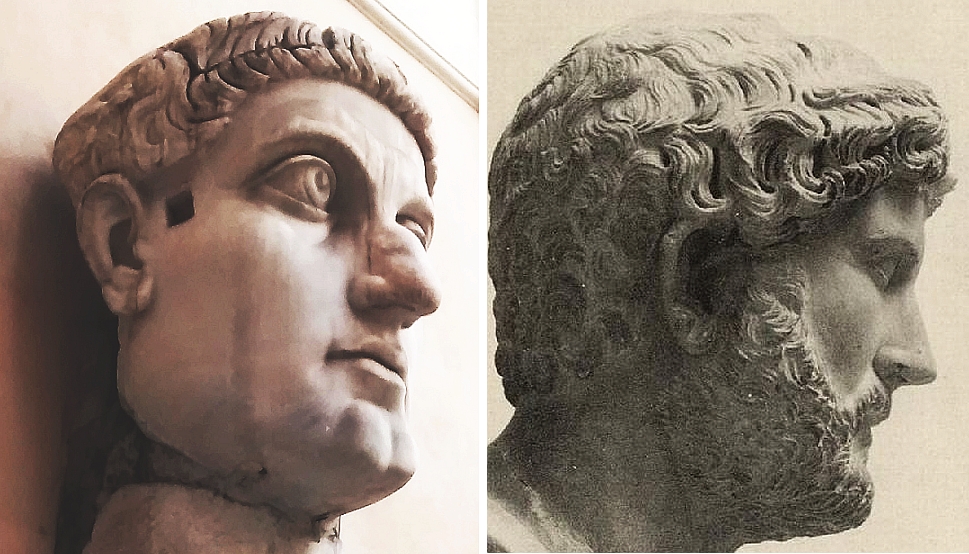
Cécile Evers (1991, 795) has arrived at her conclusion that the colossal portrait of Constantine (cf. here Figs. 11; 11.1) had originally represented Hadrian for the following reasons :
a) following Paul Zanker (1985 I, 149, cat. no. 122, quoted verbatim supra), Evers suggests that the curly coiffure of this portrait of Constantine the Great (cf. here Fig. 11) does not occur at any of the known portraits of Constantine, which is why it must belong to the original portrait of Hadrian. Evers also follows Zanker concerning his observation that the shape of this head of Constantine and its coiffure rule out the possibility that the original portrait could have represented Maxentius;
b) because at close inspection she found out that the man, whom this portrait had originally represented, was bearded;
c) because of the remains of some curls of Hadrian's characteristic << Rollockenfrisur >> at both of Constantine's temples;
d) because of the shape of Constantine's nose; and -
e) because of Constantine's ear lobes, that, in Evers' opinion, preserve the original portrait unchanged, and that are rendered precisely as in all undisputed portraits of Hadrian in the round: "Ces oreilles, grandes, carnues, aux lobes pourvus d'un pli en forme de fourche".
To illustrate Evers' above-mentioned point c), we compare here a photo of the portrait of Constantine by Franz Xaver Schütz (6-III-2020) with a photo of a portrait of Hadrian at Sevilla, published by Max Wegner (Hadrian, Plotina, Marciana, Matidia, Sabina, Berlin 1956, 13): "Sevilla, Museo Aqueologico Provincial, Sala VIIIa", Taf. 11, right.
Scholars call Evers' "fourche sur le lobe" of portraits of Hadrian, mentioned above in point e), a "crease in the ear lobe", the "disegno del padiglione auricolare", or the "charakteristische Falte in den Ohrläppchen".
Apropos, Hadrianeum: I ask myself, whether we still have remains of the cult-statue of Divus Hadrianus from the Hadrianeum.
See below, at:
A Study on the colossal portrait of Hadrian (now Constantine the Great) in the courtyard of the Palazzo dei Conservatori at Rome (cf. here Fig. 11) ...; at Part I. The statue of Hadrian (now Constantine the Great) in the courtyard of the Palazzo dei Conservatori (cf. here Fig. 11), the inscription (CIL VI 974 = 40524; cf. here Fig. 29.1), and the cult-statue of Divus Vespasianus in the Temple of Divus Vespasianus. With The Contribution by Hans Rupprecht Goette on the reworking of the portrait of Hadrian (now Constantine the Great).
The introduction to this Chapter reads: `In the following will be discussed the colossal acrolithic statue of Hadrian (now Constantine the Great) at the Palazzo dei Conservatori (here Figs. 11; 11.1) ... So far we do not know, for which context this colossal portrait of Hadrian had been created, but it is tempting to ask, whether this could have been the cult-statue of Divus Hadrianus in the Hadrianeum, built by Antoninus Pius [my emphasis]´.
I am aware of the fact that the Hadrianeum is still mentioned in the Constantinian Regionary Catalogues; cf. Mafalda Cipollone (1996, 7). By nevertheless tentatively suggesting this, my idea has in one respect similarities with La Rocca's and Kosmopoulos's hypothesis (2023, 130, 138), according to which the Templum Gentis Flaviae could have been destroyed when the Baths of Diocletian were built, although both authors know perfectly well that also that building is still mentioned in the Constantinian Regionary Catalogues and in another late antique source. In my opinion, in the case of my own hypothesis, only new evidence and/ or new ideas to interpret the known evidence, can help us to find out the truth concerning this matter.
Nachtrag vom 26.9.2024: In the meantime I was able to solve this problem, see now "Konstantin, Hadrian, Koloss, Rom, Kapitel 9" (https://fortvna-research.org/FORTVNA/FP3/Konstantin_Hadrian_Koloss_09.html).Datenschutzerklärung | Impressum